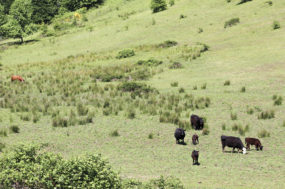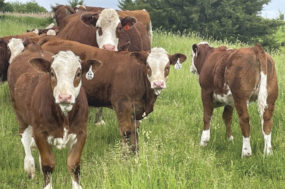Extension specialists spend considerable time discussing winter-feeding beef cow rations, frequently recommending to test forages, balance rations and ensure nutrient requirements are met. Then spring arrives and cows are put out to grass. While spring grass is always a welcome sight, lush and washy forages can pose nutritional challenges.
The first challenge is dry matter (DM). Wet, washy grass decreases nutrient density in the ration. During rapid spring growth, most forage samples will be below 20%-25% DM. This requires a lactating 1,400-pound cow with average milk to consume more than 130 pounds of fresh grass to meet her energy requirement. If the cow is a higher milking cow, she would need to eat more than 150 pounds of fresh grass. In most cases, the cow fills up her rumen between 100-125 pounds. Physical fill can limit performance when grazing washy grass.
The second challenge is the high protein content of lush forages coupled with moderate energy content. Excess protein can be a problem when energy supply is short. When rumen microbes are presented with a diet that is excess in protein and deficient in energy (low in carbs, fats and sugars), deamination of protein occurs. This process results in the production of ammonia and a carbon skeleton that can enter the Krebs cycle for energy production. Ammonia produced from this process crosses into the blood via the rumen epithelium. Ammonia is then converted to urea by the liver and excreted in the urine. Excess protein has been well documented by the dairy industry as a detriment to reproductive performance.
The third challenge is fiber. The low fiber content of immature forages results in very high passage rates and an unsatisfied cow. It seems odd that cows would be unsatisfied while knee-deep in green grass. However, I have observed this several times. Cows will readily consume a low level of dry grass hay with lush pasture. This can help add DM and fiber.
While there are numerous solutions to remedy this short-term problem, the main goal needs to be supplying cattle with a balanced ration to avoid poor, delayed breedup. Strategies may include:
- Delaying turnout until grass matures a bit more.
- Leave enough residual forage to add DM to lush, new growth.
- Offer bales of palatable, dry forage that is low or moderate in protein (not alfalfa hay).
- Supplement with corn (not over 0.5% of bodyweight), soybean hulls or high-energy feeds.
- Graze only the top third of the grass plant, which is highest in sugars.
- Shift calving season and align breeding with more nutrient-dense grass.
- Provide appropriate mineral supplementation.
Turnout frequently coincides with breeding season. Make sure you are balancing your pasture ration to safeguard cow health and timely breeding.








